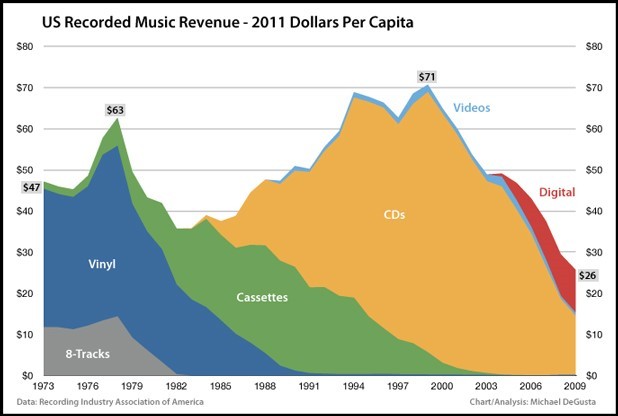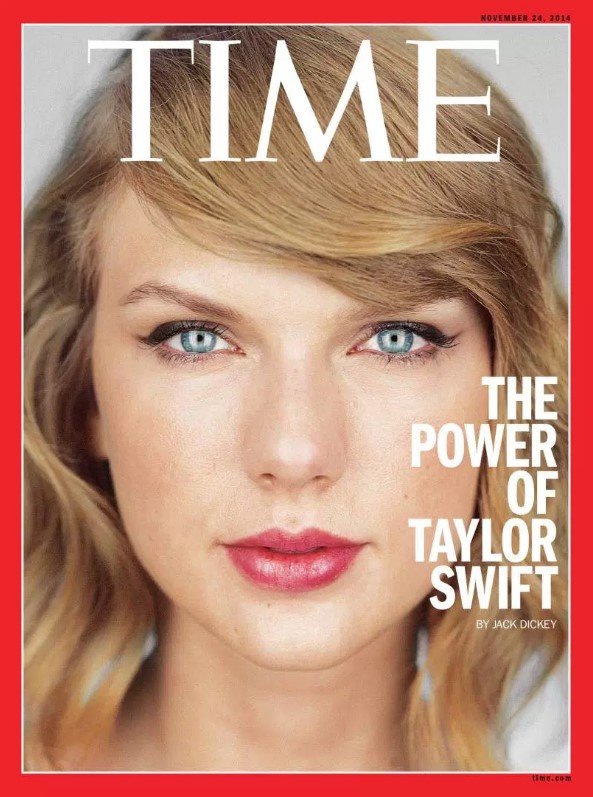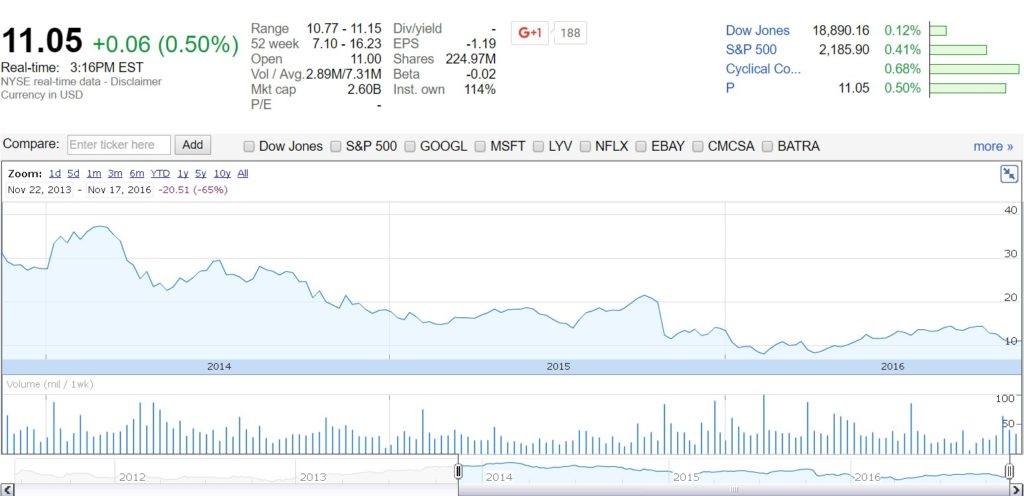Spotting and Taking Advantage of the Digitization of Music, Why Spotify is Winning the Digital Music Delivery Battle

With 100+ million subscribers, Spotify has gotten out to a big lead in the digital music delivery space by understanding digital trends before others
Spotify was founded by David Ek and Martin Lorentzon in Sweden in 2006. The vision of the platform was to build an interactive streaming service that served as a substitute to the wide spread piracy that was occurring in the music industry in the 2000’s but also provided a customizable and flexible experience for users to listen to music without purchasing dozens of music albums[1].
As depicted in Figure 1, over the decades music has been delivered to listeners through a variety of mediums. From Vinyl and Cassettes in the 1970s and 1980s to CD’s in the 1990s and 2000s and finally through digital delivery in the 2000s and 2010s[1]. The onset of digital access to music created complications in the industry as it led to a sharp increase in piracy[2] [3]. Consumers across the globe had access to illegal file sharing platforms that enabled them to download music for free from peers. The increase in piracy created significant challenges in the music industry, leading to steep declines in revenues for record companies and artists in the 2000s[2].
Figure 1
http://www.businessinsider.com/these-charts-explain-the-real-death-of-the-music-industry-2011-2
The challenges in the music industry in the 2000s presented a significant opportunity for companies to explore what the right approach to bringing legal and digital music delivery to the mass market of consumers. Founders Ek and Lorentzon built an innovative business model in the space that created value for customers by allowing them to have access to a broad library of music that was customizable and interactive. The platform was free with a limited set of features or $9.99 if users wanted the full suite of features[1]. The real genius of the Spotify business model is that it convinced record labels and artists that Spotify was a better alternative to allowing consumers to continue pirating music[1]. Despite the fact that the record label and artists get significantly less payment from Spotify than independently selling an album or single, they would have gotten $0 if the music were pirated. The operating model of Spotify is also well executed; they have a user-friendly interface that empowers the user to customize in whatever manner they want[1]. Additionally, the freemium approach to pricing attracts users to the platform for free for an indefinite amount of time while Spotify attempts to up-sell consumers to the premium $9.99 SaaS product. Their product was more attractively priced than alternatives like iTunes and gave users more flexibility than alternatives like Pandora[4]. The use of technology to deliver music in a user-friendly manner and through the right mediums like smartphone and tablet before competitors was critical to Spotify’s mass adoption[5].
Some however are critical of Spotify’s model and argue that they are not paying artists a fair share of what they deserve. On average Spotify pays out between $0.006 and $0.008 per song stream to the right holders and generally artists only get 15-20% of that streaming revenue[6]. The conflict with artists made media headlines when Taylor Swift vocally pulled her music from the Spotify platform stating “Music is art, and art is important and rare. Important, rare things are valuable. Valuable things should be paid for. It’s my opinion that music should not be free, and my prediction is that individual artists and their labels will someday decide what an album’s price point is. I hope they don’t underestimate themselves or undervalue their art.”[7] Refer to Figure 2 to see Spotify’s methodology for calculating artist payouts.
Figure 2
http://time.com/3581487/taylor-swift-spotify-borchetta/
Photograph by Martin Schoeller for TIME
Figure 3
http://time.com/3554468/why-taylor-swift-spotify/
Some are also critical of Spotify because they are uncertain about how sustainable the business model is. As the company has grown to 100+ million subscribers and 30+ million paying subscribers and €2 billion in revenues it’s losses continue to increase. Most recently with a loss of €173 million in 2015[8]. The difficulty with the freemium model is that all of the free users which are more than 2/3rds of the user base are unprofitable and are being subsidized by the paying customers. Therefore, the company will have to drastically increase its number of paying customers to become profitable[8].
Finally, to those who believe that what Spotify has done is easily replicable, look no further than Pandora and Tidal as examples of how difficult digital music delivery to consumers can be as a business. Tidal, launched by famous music insider Jay Z found that getting subscribers to join the platform was easier said than done[9]. Even with significant capital investment and calling on relationships in the music industry Tidal has only attracted 3 million subscribers compared to Spotify’s 100+ million[9]. As shown in Figure 4, Pandora has had significant difficulties as well, displayed by its stock price plummeting 70% in the last three years from a high of $37.42 down to $11.05. (795 Words)
Figure 4
https://www.google.com/finance
[1] Adeshoye, A. (2012, January 3). Retrieved from Northwestern Business Review: http://northwesternbusinessreview.org/spotify-the-next-step-in-digital-music-innovation/
[2] DeGusta, M. (2011, Febuary 18). Retrieved from Business Insider: http://www.businessinsider.com/these-charts-explain-the-real-death-of-the-music-industry-2011-2
[3] Dolan, R. (2016, August 5). Retrieved from Harvard Business School Case: https://services.hbsp.harvard.edu/services/proxy/content/51147685/51147810/e79f318b630309667202ff93517b0eda
[4] Wessel, M. (2011, July 22). Retrieved from Harvard Business Review: https://hbr.org/2011/07/why-spotify-will-kill-itunes
[5] Katz, C. (2013, December 11). Retrieved from Spotify Blog: https://news.spotify.com/us/2013/12/11/music-for-everyone-now-free-on-your-mobile/
[6] Plaugic, L. (2015, December 7). Retrieved from The Verge: http://www.theverge.com/2015/12/7/9861372/spotify-year-in-review-artist-payment-royalties
[7] Linshi, J. (2014, November 3). Retrieved from Time, Inc.: http://time.com/3554468/why-taylor-swift-spotify/
[8] Titcomb, J. (2016, May 24). Retrieved from The Telegraph: http://www.telegraph.co.uk/technology/2016/05/24/spotifys-revenue-hits-2bn-but-when-will-it-make-money/
[9] Adejobi, A. (2016, March 29). Retrieved from International Business Times: http://www.ibtimes.co.uk/tidal-one-year-has-jay-zs-music-streaming-service-been-success-failure-1552082







Nice post, Yassine. I agree with you that while I love services like Spotify as a consumer, digital music seems to be a super difficult business. Do you think that these companies can really survive as standalone services? I tend to think that Spotify probably could as the market leader, but I don’t really see much room for other players. I see the value that Apple Music could potentially create for Apple’s hardware business, as one could argue that it could increase user engagement with Apple’s high-margin devices (including its new Beats headphones) and increase sales. When I start to think about players like Pandora (which is losing popularity in the US and has limited geographic presence due to licensing restrictions) though, I have a hard time understanding how most of these services compete head-on vs. Spotify. It’d be interesting to see how services like SoundCloud grow and perform financially, as they seem to be more differentiated and target a different market / use case.
Spotify is always the first app I download on my iPhone when I get it replaced after accidentally smashing it on the ground or upgrading. My motivation for switching to Spotify over Pandora or iTunes was the fact that I could pick and choose individual songs I wanted to listen to and put them on playlists that I could download and listen to offline. In that sense, the Spotify business model was completely revolutionary and created immense amounts of value for music junkies like myself. As you point out, I would say they are only doing an OK job capturing the value that they create.
The music industry is in a tough spot. Even with apps like Spotify, piracy is still huge so it seems like artists are happy to join a huge growing app to gain at least some of the revenue they would lose from piracy.
If I were spotify, I would consider charging for additional features to increase revenue. While there are currently two tiers (4.99 and 9.99), I would consider adding another price of 19.99 that gives listeners preference when buying concert tickets. I’m not exactly sure how Spotify would structure that agreement but my willingness to pay for spotify and for concerts is much higher than 9.99 / month. While I am grateful that they have kept this price for so long, I think it is time they add a higher tier option for people like myself that would gladly pay it for preferred access to seats / concerts in general.
Thanks, Yassine. I’m an avid user of Spotify – was listening just a few minutes ago, actually – and it’s always entertaining to learn more about the companies that one supports.
I wonder about their path to profitability. Sure: they could increase their paying user base. There must be other ways though. Without interrupting their streaming music with audio commercials, in the way that Pandora does for free subscribers, could they perhaps use purely visual advertisements? In turn, the corresponding price point could be modified downward, such that revenues from advertising still break above the price savings offered to users.
Another approach would be for Spotify to start representing artist directly. Of course, representation of artists in general is on the decline given the increased access of artist to music-creating technologies (i.e. Logic, ProTools, etc.) and music-sharing platforms (i.e. Spotify, Pandora, Tidal, etc.). Given their direct relationship with artists, Spotify might be able to gain market share in this space through this sort of vertical integration by offering these services at a lower cost.
Very interesting post on a company that has changed the way we approach to music. I am a huge music fan and Spotify really changed how I find out, experience and share the music with my friends. It seems to me that the big problem they are facing right now is how to change users from the free service to the paid one. One alternative could be what they are just been doing the last couple of years, creating new content. Either the Spotify sessions, which are artists making special concerts for Spotify or their recent inclusion of Spotify videos in the app, such as Landmark, video-documentaries of important bands, Drawn & Recorded, videos that tell different stories and myths of important songs, and some more. Another alternative could be adding more value to the users in connection to the live music industry. They could associate more with concerts producers and offer discounts if you are a Spotify premium user, that way people would have more incentives to upgrade the service and make the numbers of Spotify finally turn positive.
Spotify is my go to app and as a huge music fan, I have no problem paying for the service. The issue Spotify is facing in my opinion is one of scale. Since publishing royalty costs are a proportion of revenue, they end up paying more royalties as they make more money or grow their subscriber base (even when they are winning, they are losing!) and this is all in addition to the outrageous deals with the music labels to acquire content. Since content costs keep rising, I think Spotify should actually diversify their sources of content so as to not be overly reliant on these music labels. They can explore cheaper content such as podcasts which will help reduce their content costs and set them on the path to being profitable.
I’m concerned about the streaming music industry for a couple of reasons that haven’t yet been discussed here. First, the business model depends upon writers/artists/producers/labels cooperating and the first two are not happy. Per NeYo, a prolific and successful writer, “Right now, for example, 1 million streams of a song on Pandora only earns a songwriter $90 on average. And that then has to be split with publishers too…Even if you write a hit song that’s streamed millions of times, you’re still not going to earn enough to pay the rent from streaming. And that’s where the entire industry is moving.” (http://fusion.net/story/139678/songwriters-equity-act/) Additionally, as new artists seek to break out by pursuing distribution over profits, sites like noisetrade.com facilitate distribution on a ‘tips only’ model that could become a new norm when successful new bands go mainstream. If not completely overtaking traditional pay-per-listen fee structures, “free” and other distribution mechanisms could quickly whither Spotify’s market.
Second, a marked decrease in per-song purchase prices by the likes of iTunes could turn the tables in a hurry. At $10/month, a user will pay as much for year’s worth of streaming (after which they lose all access to the music) as it would cost to purchase 120 of their favorite songs for permanent ownership. After 10 years, a Spotify user will be left with nothing but memories while a music purchaser at *current* rates would have 70 hours of hand-selected music to listen to for life (at $1 cost and 3:30 duration per song) . Given that many users’ music tastes become fixed in a given period or genre, that 70 hours may satisfy the majority of their music demands for life.
I don’t think Spotify will stand the test of time. Within a decade it will be on the decline or have changed forms dramatically, if it’s still around.